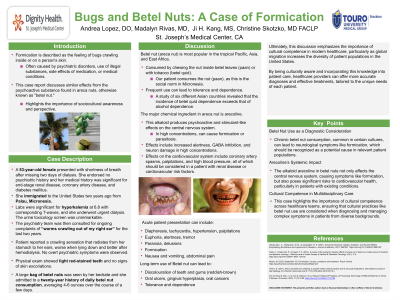Substance Use and Related Disorders
(166) Bugs and Betel Nuts - A Case of Formication


Andrea Lopez, DO (she/her/hers)
Resident Physician
St. Joseph's Medical Center
Stockton, California
Andrea Lopez, DO (she/her/hers)
Resident Physician
St. Joseph's Medical Center
Stockton, California
Madalyn Rivas, MD
Resident Physician
St. Joseph's Medical Center
STOCKTON, California
Madalyn Rivas, MD
Resident Physician
St. Joseph's Medical Center
STOCKTON, California
Ji H. Kang, MS
Medical Student
Touro University California
Stockton, California
Ji H. Kang, MS
Medical Student
Touro University California
Stockton, California
Presenting Author(s)
Co-Author(s)
Background/Significance:
Formication is described as the feeling of bugs crawling inside or on a person's skin, which can often be caused by psychiatric disorders, use of illegal substances, side effects of medication, or medical conditions (Moore, 2023). This case report discusses similar effects from the psychoactive substance found in areca nuts, otherwise known as "betel nut", and the importance of sociocultural awareness and perspective. A 53-year-old female presented with shortness of breath after missing two days of dialysis. She endorsed no psychiatric history and her past medical history was significant for end-stage renal disease, coronary artery disease, and diabetes mellitus. She immigrated to the United States two years ago from Palau, Micronesia. Labs were significant for hyperkalemia at 6.8 with corresponding T-waves, and she underwent urgent dialysis. The urine toxicology screen was unremarkable. The psychiatry team was then consulted for ongoing complaints of “worms crawling out of my right ear” for the last two years. The patient reported a crawling sensation that radiates from her stomach to her ears, worse when lying down and better after hemodialysis. No overt psychiatric signs or symptoms were observed. Physical exam showed light red-stained teeth and no signs of skin excoriations. A bag of betel nuts was seen by her bedside and she admitted to a twenty year history of daily betel nut consumption, averaging 4-6 ounces over the course of a few days. Betel nut is most popular in the tropical Pacific, Asia, and East Africa. It can be consumed by chewing the nut inside betel leaves (paan) or with tobacco (betel quid) (Athukorala, 2021). Our patient consumes the nut (paan), as this is the social norm in Micronesia. Frequent use can lead to tolerance and dependence, as a study of six different Asian countries revealed that the incidence of betel quid dependence exceeds that of alcohol dependence (Athukorala, 2021). Arecoline, the alkaloid found in areca nuts, produces psychoactive and stimulant-like effects on the central nervous system, and in high concentrations, can cause formication or parasitosis. These effects also include euphoria, warmth, increased alertness, GABA inhibition, and neuron damage in high concentrations. Effects on the cardiovascular system include coronary artery spasms, palpitations, and high blood pressure, all of which should be considered in a patient with renal disease or cardiovascular risk factors (Garg, 2014). Conclusion/Implications: This case emphasizes the importance of clinicians remaining mindful, inquisitive, and always considering diverse cultural beliefs and practices when evaluating patients with unusual symptoms. Athukorala, I. A., Tilakaratne, W. M., & Jayasinghe, R. D. (2021). Areca Nut Chewing: Initiation, Addiction, and Harmful Effects Emphasizing the Barriers and Importance of Cessation. Journal of addiction, 2021, 9967097. https://doi.org/10.1155/2021/9967097 Garg, A., Chaturvedi, P., & Gupta, P. C. (2014). A review of the systemic adverse effects of areca nut or betel nut. Indian journal of medical and pediatric oncology: official journal of Indian Society of Medical & Paediatric Oncology, 35(1), 3–9. https://doi.org/10.4103/0971-5851.133702 Moore, M. (2023, September 19). Formication: Causes, symptoms and treatment. Psych Central. https://psychcentral.com/disorders/formication#treatment
Case:
Discussion:
References:
Presentation Eligibility: Not previously published or presented
Diversity, Equity, and Inclusion: In the case presented, betel nuts were suspected as the potential cause for the patient's symptoms due to her country of origin, recent immigration to the U.S., and physical and mental status examination. In order to fully understand and effectively treat our patient, it was helpful to know her background, commonly used substances and their short and long-term health consequences in that specific region, traditional social practices, cultural importance of the areca nut, and behavioral motivations for chewing. Knowledge of these can not only minimize harm to the patient and improve health outcomes but also reduce disparities in healthcare.

